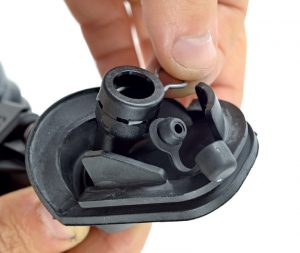One out of every two modern vehicles is now equipped with a hydraulic system, with more and more VMs demanding newer hydraulic technologies. Recent technological developments have helped increase comfort for drivers, reduce pedal load and improve efficiency of the release system. Here, Valeo Service UK advises technicians on what to do when faced with a faulty hydraulic actuation system – the cause of many clutch failures.
Can I repair hydraulic components?
No, repairing is not possible. Always use new parts if replacement is necessary. During each clutch replacement or once an actuation problem is detected, it is important to check all of the components in the transmission line, from the pedal to the gearbox. This will avoid unnecessary replacement of expensive components and unexpected labour costs.
 Can I grease the Clutch Master Cylinder (CMC) and Clutch Release Cylinder (CRC) connectors to avoid noise?
Can I grease the Clutch Master Cylinder (CMC) and Clutch Release Cylinder (CRC) connectors to avoid noise?
This is a common mistake made by repairers. To avoid noise, the hydraulic connectors must not be greased. Grease is a mineral-based oil and if the seals come into contact with it, it will cause deformation, leading to leakage. If there is noise, check whether it is generated by the hydraulic system or the mechanical system, as many noise problems are generated in the pedal area.
What kind of lubricant is used; can I use another fluid other than the fluid proposed by the car manufacturer?
Valeo Brake Fluids DOT 3, DOT 4 and DOT 4+ are used for applications with a manual gearbox. Always refer to the Vehicle Manufacturer’s manual to identify the specific hydraulic fluid required. Failure to do so may cause cross-contamination and cause the internal seals to fail prematurely.
How should I bleed the air out of the hydraulic circuit?
In the majority of vehicle applications, there will be a bleed nipple attached to the cylinder. To drain or remove air from the hydraulic line and cylinder, do the following:
- Attach a flexible transparent pipe to the bleed nipple and submerge it below the level of hydraulic fluid (use a container or can use a one-way valve/bleeding kit).
- Open the bleed nipple.
- Gently press the clutch pedal down to the floor and allow the pedal to return to its stop. Repeat the cycle.
- Periodically keep topping up the clutch/brake master cylinder reservoir as the hydraulic fluid empties out through the pipe.
- When all air has been removed, retighten the bleed nipple.
Should I remove the protection plug before fitting?
Do not remove the protection plugs before installation. If for any reason you need to separate the hydraulic components from the hose, use the protection caps.
Can I test the CSC before fitting?
The CSC can be tested via specific types of equipment which do not exist in a standard garage. But testing the seals of a new CSC or CRC from Valeo is not necessary as the company controls 100% of the production.










